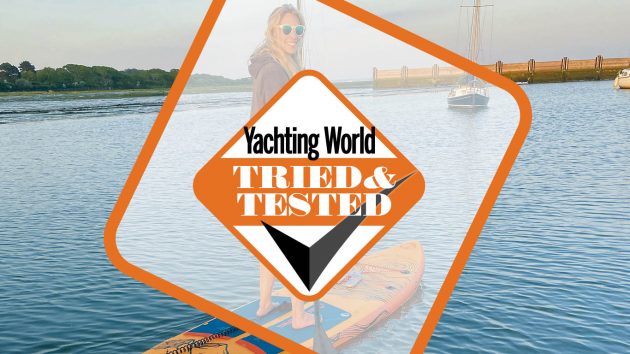Yachting Monthly editor, Theo Stocker tests out the Spinera Light 10ft 6in stand up paddle board to find out if it's light weight interferes with performance
Spinera Light 10ft 6in stand up paddle board review
Paddle boards are a brilliantly simple way of getting around an anchorage. Their simplicity, lack of bulk and the fact that they are fun to use have made them almost ubiquitous aboard cruising boats and if you want a light weight one, then the Spinera Light 10ft 6in stand up paddle board might well be for you.
The only downside of the touring board I’ve been using up to now is it’s size and weight, at nearly 14kg, and I was keen to try something that was lighter and less bulky to stow. The Spinera Ultralight range does just that. The 9ft 10in board weighs 6.2kg and the 10ft 6in version 6.7kg. There is also a large 11ft 2in board that comes in at 7.3kg.
The 9ft 10in is lighter even than the lightest Compact board from Red Paddle (£1,399), with a higher volume for more rider weight. The board I tested was the 10ft 6in version version recommended for riders of 95kg (though I have also tested the 9ft 10in version too, which has many of the same characteristics but rated for a 80kg rider).

The board pumped up well to 15PSI with the included pump
In terms of buoyancy both options are pretty good for me as I fall between the two weights. However, the narrower width of 30.5 inches on the smaller board required a little more concentration on balance at first, though I managed to avoid a dunking and enjoyed its manoevrability.
The larger board at 32.8in wide wasn’t a problem at all, and I’d have happily put one of our children sitting on the front, as we do with our old board (in a lifejacket of course). I found the twin 9in fins made the boards track straight and the boards felt easily driven when paddling. The fins were easy to mount and unmount, as long as the grooves were free of sand.
The real winner for me – and the reason these are two of the best paddle boards I’ve tested – was the weight and pack size. Made with Single Layer ULT (Ultra Light Technology) Dropstitch, they roll up very small and can even be folded in half first. The total weight for the whole package for each board (board, rucksack, two-speed pump, leash, two fins, and three-piece aluminium paddle) came it at 11.1kg (9.10) and 11.7kg (10.6).

Plenty of space to store a drybag
While I can’t yet comment on their longevity, the boards certainly seem well-built with no obvious flaws or cheap construction. They held the recommended 15PSI of air pressure, and there was no evidence of flex on the water (which makes boards slower and harder to balance).
I only find two minor issues with the board. They are so light that when you are carrying them with the central handle that the twin fins are heavy enough to make the board unbalanced and tail heavy. Remove these, however, and the board is well balanced around the carrying handle.
The other minor issue was that the soft EVA foam pads are restricted to just the central part of the board, to save weight and bulk, so if you’ve got more than one person on board, or your playing in some waves, the front and back of the board lack grip, though you could add more pads, or rub on some surf wax.
For normal paddling, however, the pads were totally sufficient, gripy and comfortable to stand on in bare feet. There’s also a four-point bungee strap for holding bags and gear, and a coiled leash to keep you connected to the board if you fall off.
See our guide to the best stand up paddle boards on the market
Verdict
These boards are light, easy to handle and they pack away small. The aluminium paddles worked well without too much flex, and the pump was effective at fast inflation and at high pressures. I was really impressed with the boards from what I could see of their quality, and they were fun boards to use on the water. Their weight recommendations can be stretched if you’re an experienced paddlboarder, but otherwise opt for the size up. For the price, I would highly recommend these.




